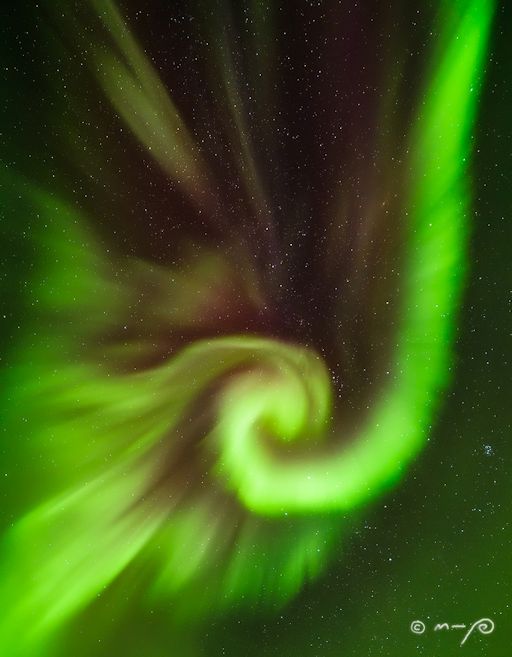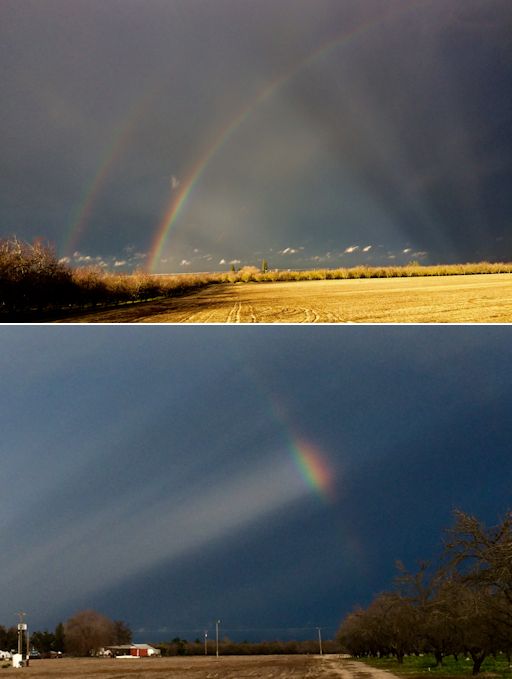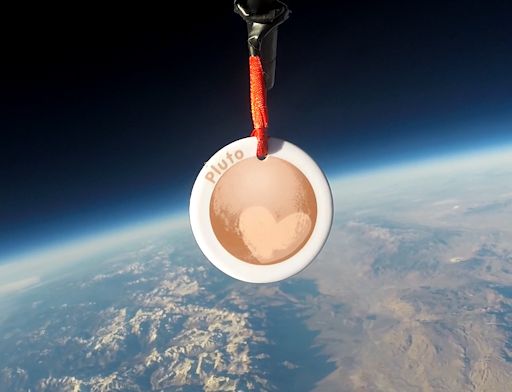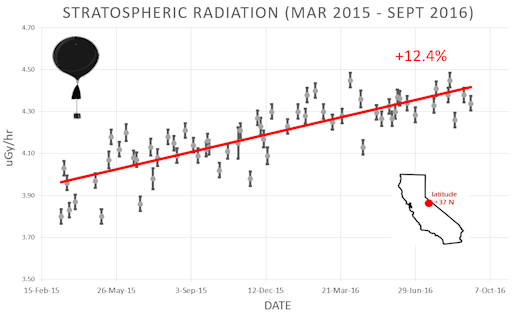Marianne's Arctic Xpress supports World Cancer Day by donating 50% of the price paid on all bookings Feb. 3-5 to cancer research. Arctic clothing and semi-pro cameras included. Groups of 2 to 8 welcome. Book Now | | | WEEKEND AURORA WATCH: Earth is beginning to exit a stream of solar wind flowing from a large hole in the sun's atmosphere. As a result, NOAA forecasters have lowered the odds of a geomagnetic storm today to only 35%. Arctic sky watchers should nevertheless remain alert for midnight auroras on Feb 3-4 as the solar wind speed is still near 600 km/s. Free: Aurora alerts.
When the solar wind stream first arrived on Jan. 31-Feb. 1, it delivered a blow to Earth's magnetic field that sparked locally intense lights around the poles. M-P Markkanen observed this outburst over Lemmenjoki National Park in the Lapland of Finland: 
"It was a mind blowing spectacle!" says Markkanen. "All night long, the sky was a showcase of aurora forms and colors -- green, red, pink, purple, white, arcs, curtains, coronas, pulsing, and at times the whole sky was just glowing green from north to south." Realtime Aurora Photo Gallery RAINBOW SPOKES: Rainbows are shaped like a wheel. Did you know, sometimes the wheel has spokes? Richard Sears photographed the phenomenon on February 3, 2017 from Ballico, California: 
"This morning, it was raining in the west. As the sun rose in the east, sunbeams lanced through gaps in the rain clouds. This produced a splendid atmospheric optical display with a double rainbow and 'spokes,'" says Sears.
Spokes are simply the shadows of clouds interrupting the normal arc of the rainbow. Sometimes, when clouds are moving fast across the sky, the rainbow wheel appears to rotate. That would be amazing to see. More pictures of strange rainbows may be found in Spaceweather.com's rainbow gallery.
Realtime Space Weather Photo Gallery FAR-OUT VALENTINE'S GIFT: Did you know that cosmic radiation in Earth's atmosphere is increasing? It's true. These and other findings of the Earth to Sky Calculus ballooning program are funded not by government grants or corporate donations. Instead, the students rely on crowdfunding. Hence, the "I Heart Pluto" Valentine's keepsake: 
To raise funds for their ongoing research, the students recently flew a payload-full of these to the stratosphere--and you can have one for $59.95. The ceramic disk highlights Tombaugh Regio–a.k.a. "Pluto's heart"–discovered by NASA's New Horizons spacecraft when it flew past Pluto in July 2015. The heart-shaped region is geologically active with glacial flows and towering mountains of ice. Some researchers think the icy crust of Pluto's Heart caps an underground ocean of liquid water. Each disk comes with a Valentine's card showing the item in flight and telling the story of its trip to the stratosphere. More out of this world gifts may be found in the Earth to Sky store.
Realtime Airglow Photo Gallery
Realtime Sprite Photo Gallery Every night, a network of NASA all-sky cameras scans the skies above the United States for meteoritic fireballs. Automated software maintained by NASA's Meteoroid Environment Office calculates their orbits, velocity, penetration depth in Earth's atmosphere and many other characteristics. Daily results are presented here on Spaceweather.com. On Feb. 3, 2017, the network reported 18 fireballs.
(18 sporadics)  In this diagram of the inner solar system, all of the fireball orbits intersect at a single point--Earth. The orbits are color-coded by velocity, from slow (red) to fast (blue). [Larger image] [movies] Potentially Hazardous Asteroids ( PHAs) are space rocks larger than approximately 100m that can come closer to Earth than 0.05 AU. None of the known PHAs is on a collision course with our planet, although astronomers are finding new ones all the time. On February 3, 2017 there were 1772 potentially hazardous asteroids. Notes: LD means "Lunar Distance." 1 LD = 384,401 km, the distance between Earth and the Moon. 1 LD also equals 0.00256 AU. MAG is the visual magnitude of the asteroid on the date of closest approach. | | Cosmic Rays in the Atmosphere |
Readers, thank you for your patience while we continue to develop this new section of Spaceweather.com. We've been working to streamline our data reduction, allowing us to post results from balloon flights much more rapidly, and we have developed a new data product, shown here: 
This plot displays radiation measurements not only in the stratosphere, but also at aviation altitudes. Dose rates are expessed as multiples of sea level. For instance, we see that boarding a plane that flies at 25,000 feet exposes passengers to dose rates ~10x higher than sea level. At 40,000 feet, the multiplier is closer to 50x. These measurements are made by our usual cosmic ray payload as it passes through aviation altitudes en route to the stratosphere over California. What is this all about? Approximately once a week, Spaceweather.com and the students of Earth to Sky Calculus fly space weather balloons to the stratosphere over California. These balloons are equipped with radiation sensors that detect cosmic rays, a surprisingly "down to Earth" form of space weather. Cosmic rays can seed clouds, trigger lightning, and penetrate commercial airplanes. Furthermore, there are studies ( #1, #2, #3, #4) linking cosmic rays with cardiac arrhythmias and sudden cardiac death in the general population. Our latest measurements show that cosmic rays are intensifying, with an increase of more than 12% since 2015: 
Why are cosmic rays intensifying? The main reason is the sun. Solar storm clouds such as coronal mass ejections (CMEs) sweep aside cosmic rays when they pass by Earth. During Solar Maximum, CMEs are abundant and cosmic rays are held at bay. Now, however, the solar cycle is swinging toward Solar Minimum, allowing cosmic rays to return. Another reason could be the weakening of Earth's magnetic field, which helps protect us from deep-space radiation. The radiation sensors onboard our helium balloons detect X-rays and gamma-rays in the energy range 10 keV to 20 MeV. These energies span the range of medical X-ray machines and airport security scanners. The data points in the graph above correspond to the peak of the Reneger-Pfotzer maximum, which lies about 67,000 feet above central California. When cosmic rays crash into Earth's atmosphere, they produce a spray of secondary particles that is most intense at the entrance to the stratosphere. Physicists Eric Reneger and Georg Pfotzer discovered the maximum using balloons in the 1930s and it is what we are measuring today. | | The official U.S. government space weather bureau | | | The first place to look for information about sundogs, pillars, rainbows and related phenomena. | | | Researchers call it a "Hubble for the sun." SDO is the most advanced solar observatory ever. | | | 3D views of the sun from NASA's Solar and Terrestrial Relations Observatory | | | Realtime and archival images of the Sun from SOHO. | | | from the NOAA Space Environment Center | | | a proud supporter of science education and Spaceweather.com | | | the underlying science of space weather |  | Beautyz for top beauty products reviews and their buying guides | | | These links help Spaceweather.com stay online. Thank you to our supporters! | | 
